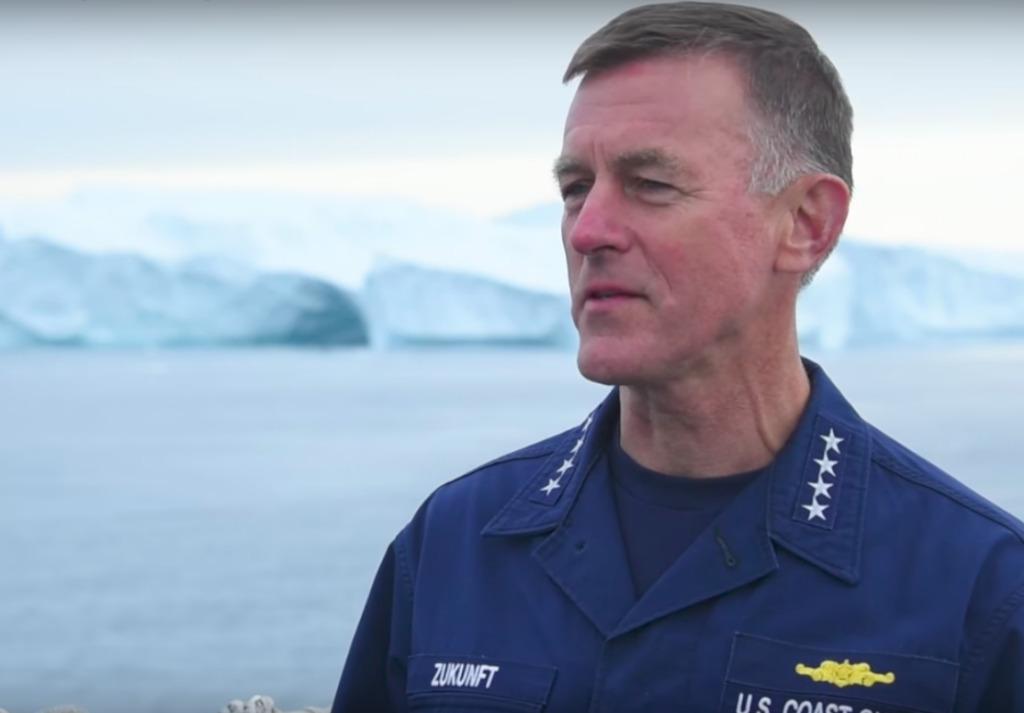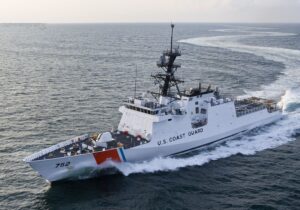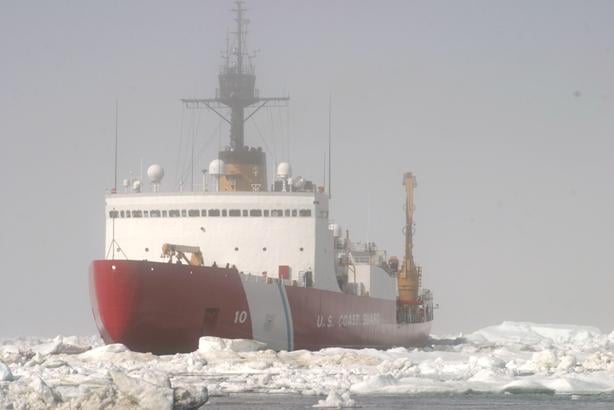Coast Guard Fears Two-Year Budget Boost Just A Blip: Adm. Zukunft
Posted on

Adm. Paul Zukunft in Greenland
WASHINGTON: The Coast Guard, like the Army, is grateful for historic increases in the 2018 and 2019 budgets, which reverse a seven-year decline in readiness funding, but the outgoing commandant is deeply concerned things will get worse soon. Even if Congress forestalls sequestration in 2020, warned Adm. Paul Zukunft, the long-term trends of an aging population and rising debt will put heavy pressure on the budget.
“There’s going to be question marks way beyond that, Sydney,” Zukunft said after I asked about 2020. “I look at an aging population. We’ve got tax reform. We’ve got a lot of potential conflict out in the world today… What is the discretionary budget going to look like in ’22, ’23, and beyond?”
If you think the competition for budget dollars is intense today, Zukunft warned reporters at a Defense Writers’ Group breakfast, “it’s going to be even more competitive tomorrow.”

Mark Esper
The Coast Guard isn’t the only service looking with an anxious eye beyond the current two-year budget deal. Army Secretary Mark Esper and his under secretary, Ryan McCarthy, have both said they are combing the service’s budget for potential savings — including cancelling procurement programs — to ensure adequate funding for their “Big Six” modernization priorities even if Budget Control Act caps return.
Meanwhile, the Navy is soft-pedaling its plan to build a 355-ship fleet, with undersecretary Thomas Modly telling the Sea-Air-Space conference the Navy won’t reach 355 ships until 2052 — not exactly a sign of long-term fiscal confidence. Zukunft didn’t speak at Sea-Air-Space but multiple Coast Guard officers and officials did, a sign of the closeness between the Homeland Security agency and the Defense Department.
That said, Zukunft’s priorities are different from the Pentagon’s focus on modernization. In the Coast Guard, he said, “the acquisition piece is looking very healthy” — but readiness is still a concern.

Coast Guard National Security Cutter USS Stratton
After decades of neglect, the Coast Guard is replacing aging cutters, icebreakers and other equipment about as fast as the small service can absorb them, given the size of its sustainment budget, the admiral made clear. If he had one more dollar, it would go to Operations & Maintenance (O&M) — which for the Coast Guard, unlike the Defense Department agencies, also includes salaries for uniformed personnel.
For example, the Coast Guard is buying more light short-range drones for its cutters, which currently use the Scan Eagle. But before the Coast Guard invests in larger drones, it wants to assign more personnel to help Customs & Border Protection (CBP) operate the nine Predators they already have. Comparing the flight hours of Homeland Security Department’s Predators to the Defense Department’s, Zukunft said, “we are grossly underutilizing” them, because DHS just doesn’t have enough people to operate them for the prolonged, back-to-back missions the hardware is capable of.
“I’ve told folks on the Hill and I’ve testified on the record that we need five percent annualized growth in our operations and maintenance account,” Zukunft said. Four to six years at five percent growth would get the Coast Guard “above the surface of the water,” he said.
So what was the Coast Guard getting until this year? “We were getting one to two percent negative growth,” Zukunft said. “We have been underwater for seven consecutive years…. We went from 2011 to 2017 funded below the floor (i.e. the Budget Control Act caps). For us that adds up to a nearly $1 billion shortfall in operations and maintenance funding.”
“We have a $1.6 billion backlog in shore (facilities) maintenance,” he said. “We’re operating buildings that are over 100 years old (and) we got shellacked this past hurricane season.” Hurricanes Harvey, Irma and Maria hit multiple Coast Guard facilities hard, for a total bill of over $800 million — all of which was covered in the final 2018 budget.

Coast Guard heavy icebreaker Polar Star, now 42 years old
Icebreaker Uncertainties
The 2019 budget now on the Hill continues the positive trend, including $750 million to complete the purchase of the nation’s first new icebreaker in decades. “This is the highest priority for us right now,” Zukunft said. “It’s the one area where we don’t have redundancy in our national inventory.”
By law, one heavy icebreaker will be funded out of the Homeland Security budget, one out of the Defense Department. (That’s yet another sign of the striking closeness between the Coast Guard and the Navy). The icebreakers won’t be armed but will have space, weight capacity, and power set aside to install weapons if needed.

Coast Guard medium icebreaker Healy
The current plan is to build three heavies and then build three medium icebreakers — but the Coast Guard is now studying whether it makes economic sense to switch to a different design. Given the costs of designing, developing, and building the first ship of a new class, the first medium might cost as much as a fourth heavy.
“Going forward, the jury’s still out. I am pretty certain the program of record would be three heavy and three medium icebreakers, total of six….We’ve done multiple studies,” Zukunft said. “But when we start looking at the business case…maybe you end up with one class of heavy icebreakers. There’s advantages there with configuration management, maintenance, crew familiarity.”
“That’s still probably several years before we would reach that threshold but that’s one option that we want to open,” Zukunft said. For now, the service has a Request For Proposals out for icebreakers. The RFP not only covers the first heavy, but also gives contractors the option of offering a multi-year procurement deal on multiple ships. Such “block buys” can offer contractors greater stability and the government significant savings.
That said, as much as the Coast Guard wants to economize on icebreakers and everything else, Zukunft says he doesn’t want to return to the old culture of “martyrdom” when the service prided itself on doing more with less even as it ran its equipment and people into the ground. “Our entire appropriation is less than one aircraft carrier,” he said, but the service still has to state its needs forthrightly to have a chance at adequate funding.
The current budget deal makes a big down payment on ending Coast Guard martyrdom. “To say we are delighted with the ’18 consolidated budget and ’19 would be an understatement,” Zukunft said. But the Coast Guard — and other agencies — can’t count on this being the new normal rather than a short-lived exception.
Subscribe to our newsletter
Promotions, new products and sales. Directly to your inbox.
